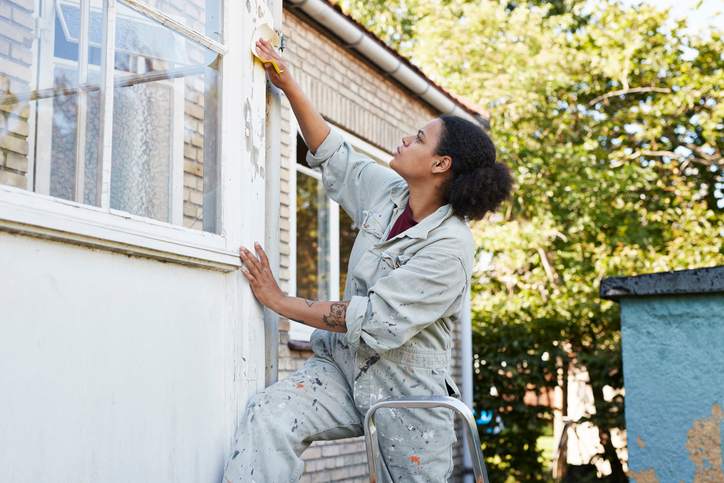If you’re thinking of selling your home or refinancing, then you’ll need an appraisal. You typically want your home to be valued at the highest price point possible, but you might be a little foggy about how the appraisal process works.
Here are some different ways you can put yourself in a good position to get the best result on your home appraisal:
- What Is an Appraisal and Why Is It Important?
- Before You Begin
- Spruce Up Your Curb Appeal
- Inside the House: Set the Stage for Success
- The Bottom Line on Improving Your Home Appraisal
What Is an Appraisal and Why Is It Important?
An appraisal is a professional estimate of a home’s fair market value. If you’re planning to sell your home or refinance, an appraisal is usually required. During the appraisal process, a licensed, third-party appraiser examines the condition of the home and compares it to similar properties in the area that recently have been sold.
The result dictates the maximum amount of the loan on the house, so it’s important to receive a good appraisal. If you’re selling, a high appraisal means you’re more likely to get your asking price. If you’re refinancing, a high appraisal could mean that you have more home equity available than expected.
Keep in mind that government-backed loans — like those issued by the Federal Housing Administration, Veterans Affairs, and the U.S. Department of Agriculture — have their own set of appraisal standards that you should familiarize yourself with, depending on your loan type.
Before You Begin
Prior to your appraisal, it’s helpful to do some research and gather key documents. Additionally, completing certain renovations and upgrades before the appraisal could help increase the value of your home and allow it to sell for a higher price.
Keep in mind that these are general ways to improve your home appraisal value, and they don’t guarantee a favorable outcome.
Research renovations and upgrades that add the most value
The appraiser considers several factors to estimate the value of your home, including the location, square footage, age, number of bedrooms and bathrooms, size of the land, and overall condition. Some of the factors that affect your home appraisal value are out of your control, such as current market conditions. However, you could increase the value of your home in other ways — like renovating.
When you’re deciding on renovations, it’s important to know the difference between what adds value to the home appraisal and what doesn’t, so you can avoid spending money on projects that won’t pay off. For example, you might think that a pool would be a luxurious addition to your property, but some buyers could see it as a drawback because they’ll have to maintain the pool.
What increases the appraisal value of a home is updating its systems to make them modern and cost-efficient. Upgrading kitchen and laundry appliances can make the home feel newer, while replacing some of the building materials can make the home safer. Some major renovations take time, so you should build them into your schedule well in advance of the appraisal.
Research appraisers
You need your appraiser to be unbiased, experienced, and knowledgeable about the area. One way to look up accredited appraisers by location is using the National Association of Realtors directory.
You can search online for the appraisers’ professional pages to find out how long they’ve been working in your area. It also doesn’t hurt to check the Better Business Bureau for any complaints that have been filed against them.
As you’re researching appraisers, here are some traits you’ll want your appraiser to have:
- They are qualified and experienced. Make sure the appraiser works with a reputable firm and has the proper credentials, including a valid state license. It’s also important to learn more about their experience. If the appraiser is still new to the game, then they might not know enough to give you an accurate valuation.
- They are familiar with your area. Because the value of your property is partially based on comparable homes in the area, it’s important that the appraiser has a good feel for the local market. If the appraiser doesn’t regularly work in the area, then their information about your area might be incomplete.
- They have worked with your home type before. An appraiser who often evaluates homes of a certain type and size will be more tuned into the fine details. For example, if you’re looking to sell a condominium, then you’ll want to look for an appraiser who specializes in condos instead of large houses.
Research comparable home prices
Part of the appraiser’s process is using “comps” — shorthand for comparable homes in your area. Typically, these are nearby homes of a similar size and style, which means they’re likely priced in the same range.
Researching what comparable homes in the neighborhood have sold for can give you a better sense of what your home is worth, and providing this information to the appraiser could help you get a more accurate valuation. It may also tell you whether the appraiser’s estimate is fair.
You can find price estimates for similar homes through online databases. However, if you want the most accurate information, visit your county offices to learn the sale prices of similar homes in your area. Your real estate agent can also help you get access to your local multiple listing service, which is a database with information on local comps.
Know the benefits of living in the area
The perks and drawbacks of living in the neighborhood play a role in determining the home’s value. Some of these considerations include:
- Amount of street noise.
- Proximity to grocery stores, restaurants, and entertainment centers.
- Quality of nearby schools.
- Job opportunities.
- Proximity to highways and public transportation.
Ideally, the appraiser will account for the benefits of your home’s location — but you can’t count on it. Showing the appraiser why your area is a great place to live can help improve your appraisal.
Create a list of past renovations and improvements
Since renovations and upgrades to your home can help increase its value, it’s important that the appraiser knows of all the improvements you’ve made. Consider keeping a file with not only a list of these improvements, but also proof of what you paid for them — including any invoices, receipts, and before-and-after photos.
Prepare an offer list and the home’s listing history
In addition to a list of comps and evidence of home improvements, there are other key documents that you can give to the appraiser to help ensure they have all the relevant information needed.
If you’ve already received multiple offers on your home, document them in an offer list.This shows your appraiser that the home is in demand and your asking price is fair.
You could also give the appraiser a rundown of how much the property has sold for in the past, which is known as the home’s listing history.
Spruce Up Your Curb Appeal
Curb appeal refers to the first impression that your home makes on the appraiser or prospective buyers. It’s all about how enticing the exterior of your home appears from the street.
This means that you’ll want to pay close attention to the condition of the roof, siding, windows, and landscaping, and make any necessary repairs or improvements. Aside from superficial changes to increase the home’s appraisal value, it’s important to address any major issues well ahead of time.
Paint the house
If the exterior paint is chipping or peeling, consider getting a fresh paint job. If you don’t want to repaint the entire home, then prioritizing the front and the most visible areas can maximize curb appeal.
In addition to the siding, be sure to check the doors and shutters. If your doors are older, then painting them a brighter color can make the doors appear newer.
Keep in mind that if your home was built before 1978, you’ll want to be careful when removing old paint, as it may contain lead.
Mow the lawn
Mowing the lawn helps keep your property looking neat and maintained, so cut the grass a day or so before the appraiser arrives. It’s advisable to keep the grass short — no more than about 3 inches — though you may want to keep it longer during the summer to prevent the grass from drying out. It can also help to rake leaves or shovel snow-covered pavement to tidy up the grounds as much as possible.
If you have a green thumb, then any garden areas you’ve been maintaining can pay off during the appraisal. You may want to plant some new flowers and lay down fresh mulch. If you research the types of plants that thrive in your area, then you can time the growth strategically to have them in bloom around the appraisal date.
Trim the trees and bushes
Trees can offer privacy and shade, but it’s important to maintain them. Overgrown trees may become unsightly and encroach upon the property, blocking out too much natural light. Also be mindful of any dead or dying trees, as loose tree branches can be a safety hazard.
Before the appraisal, arrange to have your trees and bushes trimmed. It’s often best to leave this type of work to professionals who know how to do it properly.
Fix the roof
Prospective buyers aren’t looking to have just any roof over their heads — they also want that roof to be sound. The roof is the first line of defense for a home, so problems with the roof can quickly lead to issues with the walls and ceiling. If the roof is caved in, leaking, missing shingles, or made of old materials, the appraiser is going to dock you for it.
If your roof has less than three years of life left, then you should have it repaired before the appraisal. While it’s possible for roof repairs to be completed in a few days, the project could also take a couple of weeks depending on weather conditions and the location of your home.
Catch up on maintenance
Homeowners should be up to date on general maintenance before the appraisal date. Here are some common areas to address:
- Resolve any plumbing and drainage issues.
- Make sure the water pressure and water quality are sufficient.
- Repair any issues with the electrical, heating, and cooling systems.
- Replace any broken or drafty windows and doors.
- Seal the basement or foundation if there has been any water leakage.
- Check for cracks in the walls.
- Make sure the garage door is functioning.
Major repairs — especially those that affect the foundation, roof, or electrical systems — can take longer, so be sure to give yourself enough time to complete them before the appraisal.
It’s also important to leave bigger renovations to the professionals. In particular, electrical and plumbing changes need to be done correctly, because they can present health and safety hazards that drive down the home value.
Inside the House: Set the Stage for Success
When it comes to the interior, the general condition and structural integrity of the home affect the home appraisal value. The appraiser will keep an eye out for any visible defects, and check if the major systems and appliances are functional and up to date. They will also check if the interior has been maintained and is free of any major health or safety hazards.
On appraisal day, you’ll want to make sure that the home has been thoroughly cleaned, the rooms are tidy, and any pets are out of the way.
Here’s a rundown of some additional things you can do with the interior to improve your home appraisal result.
Update the interior paint
Inspect the quality of the paint on the walls, trim, windows, and doors inside your home. If it appears old and stained or has begun to peel, you’ll want to touch up the paint.
A fresh coat of paint can be a relatively inexpensive way to make the interior of your home pop and feel less lived-in. Depending on your experience, this could be something that you handle on your own to save on labor costs.
As with the exterior paint, the interior may also include lead paint if your home was built before 1978, so take the proper precautions.
Stage the furniture with care
The furniture you purchased for your home may have been a personal choice, but you should start thinking about how it could affect the appraisal. The way you have the furniture arranged can influence the perceived size of the rooms. If a space is cluttered, you may want to remove a piece of furniture to make the room feel larger. It can also help to move furniture away from the walls to make a room feel less cramped.
Keep in mind that while it’s nice for your furniture to be in good condition, it doesn’t affect the value of the property, since those items are your possessions and not part of the home.
Clean the carpets
Carpets can get gross over time. Dirt and grime accumulate, and the fibers begin to appear worn, faded, and stained.
In comparison, hardwood floors are generally valued higher as they’re more expensive to install. If your carpeting has seen better days and you have the funds, you could upgrade to hardwood floors and increase the value of the home appraisal.
A less expensive option would be to clean or replace your carpeting to make the home feel newer. If you choose to deep-clean the carpets, be sure to allow enough time for them to dry before the appraisal date.
The Bottom Line on Improving Your Home Appraisal
Because an appraisal is an unbiased evaluation of your home and partially based on local market conditions, there are limitations to how much you can influence the result. However, there are still many steps you could take before the appraisal to increase your home’s value and make sure your property is in its best state. By maintaining your home and making improvements along the way, and researching the local market, you can help maximize your home’s value.






